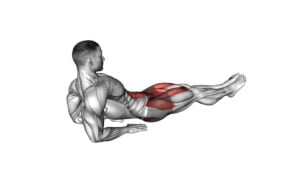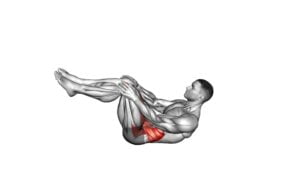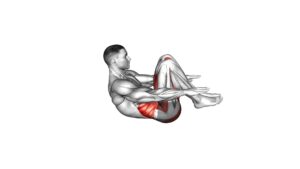Lying Leg Tuck Hip Stretch (male) – Video Exercise Guide & Tips

Are you looking for an effective hip stretch that targets your lower body? Look no further! The Lying Leg Tuck Hip Stretch is the perfect exercise for you.
Watch This Exercise Video
In this video exercise guide, we will show you the proper form and technique to get the most out of this stretch. Whether you're a beginner or an advanced fitness enthusiast, we have modifications and variations to suit your fitness level.
Get ready to incorporate this stretch into your routine and feel the benefits!
Key Takeaways
- The Lying Leg Tuck Hip Stretch is an effective exercise for improving hip flexibility.
- The exercise can help alleviate hip pain and discomfort.
- Incorporating the Lying Leg Tuck Hip Stretch into your routine can enhance overall mobility and range of motion.
- Consistency is key for long-term improvement in hip flexibility.
Benefits of the Lying Leg Tuck Hip Stretch
You will experience increased flexibility in your hip muscles by regularly performing the lying leg tuck hip stretch. This exercise offers numerous health benefits, primarily focusing on improving flexibility. Flexibility is crucial for maintaining proper posture, preventing injuries, and enhancing athletic performance. By incorporating the lying leg tuck hip stretch into your routine, you can expect to see a significant improvement in your hip mobility.
This stretch specifically targets the hip flexors, which are a group of muscles responsible for flexing and extending the hip joint. When these muscles become tight or shortened, they can limit your range of motion and cause discomfort. The lying leg tuck hip stretch helps to lengthen and stretch these muscles, promoting flexibility and relieving tension in the hips.
Increasing your hip flexibility also has a cascade effect on other areas of your body. It can alleviate lower back pain, improve your balance, and enhance your overall movement patterns. By regularly incorporating this stretch into your exercise routine, you won't only improve your hip flexibility but also experience improved overall physical performance.
Now that you understand the health benefits of the lying leg tuck hip stretch, let's move on to the next section, where we'll discuss the proper form and technique for performing this exercise.
Proper Form and Technique for the Exercise
To perform the lying leg tuck hip stretch correctly, position yourself on a mat with your legs extended and your back flat on the ground. Start by bending your right knee and bringing it towards your chest, tucking it in as close as possible. Hold this position for a few seconds, feeling a stretch in your hip flexors. Then, slowly release and repeat with your left leg. Remember to keep your back flat on the ground throughout the stretch.
Common mistakes to avoid during this exercise include lifting your lower back off the ground or letting your legs fall to the side. These errors can reduce the effectiveness of the stretch and put unnecessary strain on your lower back. It's important to maintain proper form and control throughout the movement.
Modifications and variations can be made to accommodate different fitness levels and needs. If you find it challenging to bring your knee all the way to your chest, you can start by bringing it halfway or using a towel or resistance band to assist the movement. For a deeper stretch, you can try adding a gentle twist towards the bent knee, incorporating a spinal rotation.
Remember to always listen to your body and adjust the exercise as needed. With proper form and technique, the lying leg tuck hip stretch can help improve hip flexibility and relieve tension in the hip flexors.
Common Mistakes to Avoid During the Stretch
One common mistake to avoid during the lying leg tuck hip stretch is allowing the lower back to lift off the ground. This can happen when you try to bring your knees too close to your chest without proper control. When the lower back lifts off the ground, it reduces the effectiveness of the stretch and puts unnecessary strain on the spine.
To avoid this mistake, focus on maintaining contact between your lower back and the ground throughout the stretch. Keep your core engaged and use your abdominal muscles to control the movement of your legs.
Another common mistake is rushing through the stretch. Remember to perform the stretch slowly and with control, allowing your muscles to fully relax and release tension. Rushing through the stretch can lead to improper form and limited benefits.
By avoiding these common mistakes, you can maximize the effectiveness of the lying leg tuck hip stretch and avoid potential injuries.
Now, let's move on to the next section to explore modifications and variations for different fitness levels.
Modifications and Variations for Different Fitness Levels
For different fitness levels, there are various modifications and variations available for the lying leg tuck hip stretch. Whether you're a beginner or an advanced fitness enthusiast, these modifications and progressions can help you tailor the exercise to your specific needs and abilities.
Modifications:
- If you're a beginner or have limited flexibility, you can start by performing the stretch with your knees bent instead of fully extending your legs. This will reduce the intensity of the stretch and make it more manageable.
- Another modification is to use a resistance band or towel to assist you in the movement. Simply wrap the band or towel around your feet and hold onto the ends for added support and stability.
Progressions:
- As you become more comfortable with the lying leg tuck hip stretch, you can progress by straightening your legs fully and focusing on maintaining proper form and alignment throughout the movement.
- To further challenge yourself, you can add ankle weights or hold a dumbbell between your feet while performing the stretch. This will increase the resistance and intensity, providing a greater challenge for your hip flexors and core muscles.
Tips for Incorporating the Lying Leg Tuck Hip Stretch Into Your Routine
As you incorporate the lying leg tuck hip stretch into your routine, it's important to consider these helpful tips for maximizing the effectiveness of the exercise.
Stretching techniques that focus on the hips can provide numerous benefits, such as improving flexibility, reducing tightness, and preventing injuries.
To incorporate the lying leg tuck hip stretch into your routine, start by lying flat on your back with your legs extended. Bend your right knee and bring it towards your chest, grasping it with both hands. Gently pull your knee closer to your chest while keeping your back flat on the ground. Hold this position for 20-30 seconds and then release. Repeat the stretch on the left leg.
Aim to perform this stretch 2-3 times on each leg, increasing the duration and intensity as you become more comfortable. Remember to breathe deeply and relax your muscles throughout the stretch.
Incorporating the lying leg tuck hip stretch into your routine can help increase hip flexibility, improve mobility, and alleviate hip pain.
Frequently Asked Questions
How Long Should I Hold the Lying Leg Tuck Hip Stretch for Maximum Benefit?
To get the maximum benefit from the lying leg tuck hip stretch, it's important to hold the stretch for an adequate amount of time. You should aim to hold the stretch for about 30 seconds to 1 minute. This will give your muscles enough time to relax and lengthen.
If you're a beginner, you can modify the stretch by bending your knees slightly or using a pillow under your hips for support.
To incorporate this stretch into your daily routine, try doing it after a workout or before bed for a soothing stretch.
Can the Lying Leg Tuck Hip Stretch Help With Lower Back Pain?
The lying leg tuck hip stretch, along with other hip stretches, can be beneficial for reducing lower back pain. By stretching the hip muscles, you can relieve tension in the lower back and improve flexibility.
If you're looking for alternatives to the lying leg tuck hip stretch, you can try exercises like the supine figure 4 stretch or the seated piriformis stretch.
Incorporating hip stretches into your workout routine can have several benefits for your overall mobility and comfort.
Is It Better to Perform the Lying Leg Tuck Hip Stretch Before or After a Workout?
When it comes to the lying leg tuck hip stretch, you might be wondering whether it's better to do it before or after your workout.
Well, performing this stretch before your workout can help warm up your muscles, improve flexibility, and prevent injuries.
On the other hand, doing it after your workout can help relax your muscles, reduce soreness, and promote recovery.
Can the Lying Leg Tuck Hip Stretch Improve My Flexibility for Other Exercises?
Improving your flexibility with the lying leg tuck hip stretch can definitely benefit your other exercises. By increasing your range of motion and mobility in the hips, you'll be able to perform movements with better form and efficiency. This can lead to improved performance and reduced risk of injury.
Incorporate this stretch into your routine before or after workouts to enhance your overall flexibility and support your fitness goals.
Are There Any Precautions or Contraindications for Performing the Lying Leg Tuck Hip Stretch?
Before attempting the lying leg tuck hip stretch, it's important to know about any precautions or contraindications. This information will help ensure your safety and prevent any potential injuries.
Be aware of any pre-existing conditions or injuries that may be aggravated by this exercise. It's also advisable to consult with a healthcare professional or a certified fitness instructor before incorporating this stretch into your routine.
Conclusion
Incorporating the lying leg tuck hip stretch into your routine can provide numerous benefits, such as improved flexibility and reduced hip tightness.
By following the proper form and technique, avoiding common mistakes, and making modifications based on your fitness level, you can effectively perform this exercise.
Remember to always listen to your body and consult with a fitness professional if needed.
Start incorporating this stretch into your routine today for a healthier and more mobile body.

Author
Years ago, the spark of my life’s passion ignited in my mind the moment I stepped into the local gym for the first time. The inaugural bead of perspiration, the initial endeavor, the very first surge of endorphins, and a sense of pride that washed over me post-workout marked the beginning of my deep-seated interest in strength sports, fitness, and sports nutrition. This very curiosity blossomed rapidly into a profound fascination, propelling me to earn a Master’s degree in Physical Education from the Academy of Physical Education in Krakow, followed by a Sports Manager diploma from the Jagiellonian University. My journey of growth led me to gain more specialized qualifications, such as being a certified personal trainer with a focus on sports dietetics, a lifeguard, and an instructor for wellness and corrective gymnastics. Theoretical knowledge paired seamlessly with practical experience, reinforcing my belief that the transformation of individuals under my guidance was also a reflection of my personal growth. This belief holds true even today. Each day, I strive to push the boundaries and explore new realms. These realms gently elevate me to greater heights. The unique combination of passion for my field and the continuous quest for growth fuels my drive to break new ground.







